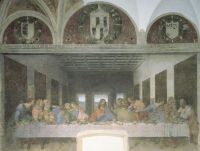The Body of Man Click on the thumbnails to explore the trail
Read more about this trail (expand)
According to Leonardo, man himself was at the centre of everything– “The measure of all things”. Throughout his life, the artist engaged in a dynamic and increasingly in-depth examination of man as a living organism, embarking on a seemingly unending quest to discover how man moved, grew, developed and perceived the world in which he lived.

- Enlarge
- Zoom & explore
- © SPSAE, Milano
Last Supper c1495-98
During the 15th century, Florentine painters firmly believed that the motions of the mind should be apparent in the facial expressions and bodily gestures of their painted figures. This was seen to be particularly important in the case of narrative paintings.
For his painting of the Last Supper, Leonardo chose not to illustrate the moment when Judas was identified as a traitor, as was traditional. Instead he represented the preceding moment when Christ first declared the shocking words, “Verily I say unto you that one of you will betray me.” (Matthew 26:21).
Leonardo portrays the Apostles as propelled into motion by the “animal spirits” conveyed through their bodies from their sensus communis – the very seat of their soul that resides in the brain. As such, the individual movements of each figure speaks the bodily language of their mind. Leonardo has broken the convention of representing Judas alone on the other side of the table, as was the tradition in paintings of the Last Supper at that time. His stiff reaction and ugly features, which are obscured in deep shadow, make him all too apparent.
In Leoanrdo's words
One who was drinking has left his glass in its place and turned his head towards the speaker. Another wrings the fingers of his hands and turns with a frown to his companion. Another with hands spread open to show the palms shrugs his shoulders up to his ears and mouths astonished. Another speaks into his neighbour’s ear, and the listener twists his body round to him and lends him his ear while holding a knife in one hand and in the other some bread half cut through by a knife.
One of Leonardo’s most famous paintings, and famous during his own lifetime, the Last Supper is now but a shadow of its former self as it would have appeared on completion in 1497. A combination of the unorthodox painting techniques employed by Leonardo, the pervading dampness of the refectory wall and repeated programmes of restoration that began as early as 1517, have all contributed to the substantial deterioration of the painting.
However, the most recent campaign of restoration completed in 1999 seems to have halted the deterioration of the painting’s surface and brought to light the original colour of the work. Furthermore, previously unobserved details are now apparent, such as the wall-hangings and their patterns seen on the side walls of the room in which the “Last Supper” takes place and the objects on the table.
The coats of arms that appear in the lunettes above the painting indicate that the painting was not commissioned by the monks of Santa Maria delle Grazie, but by Ludovico Sforza, who was also the patron of the new choir of the church of Santa Maria delle Grazie, which was intended as a family mausoleum for Ludovico and his family. The fact that the Last Supper is described in glowing terms by Luca Pacioli in his Divina Proportione, dedicated to Ludovico Sforza in February 1498, indicates that the painting was probably completed some time in 1497.
Pacioli mentions how the painting describes the moment at which Christ announced, “One of you shall betray me” (Matthew 26:21).
- Medium Oil and tempera on plaster
- Size 460 x 880 cm
- Location Santa Maria delle Grazie












